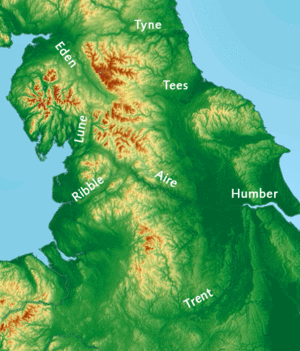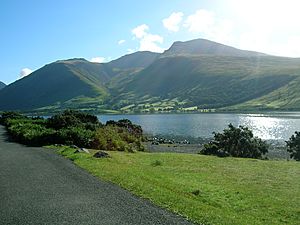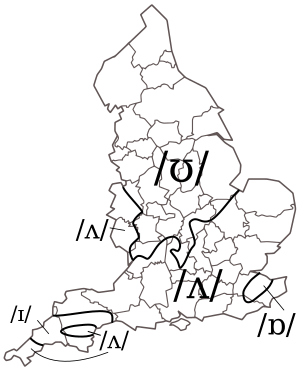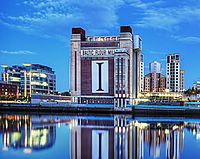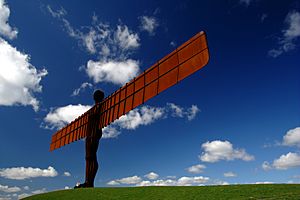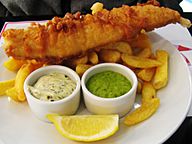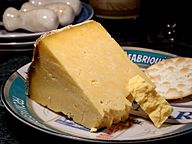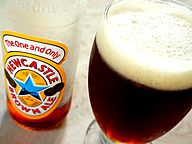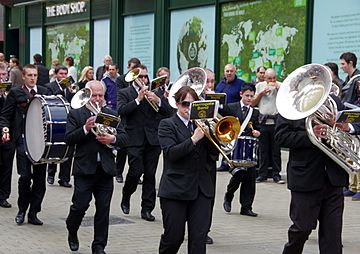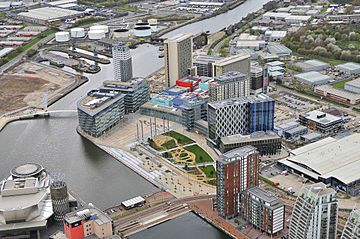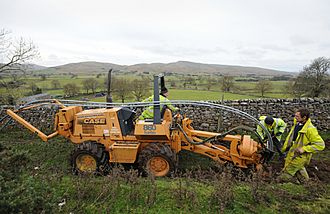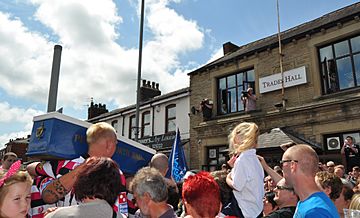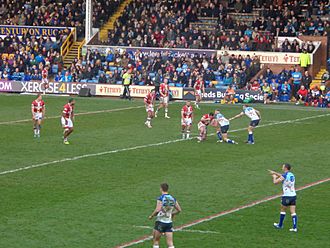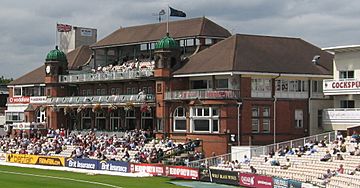Northern England facts for kids
Quick facts for kids
Northern England
North of England / the North
|
|
|---|---|
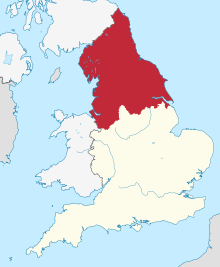
The three current Northern England government regions shown within England, without regional boundaries. Other cultural definitions of the North vary and have changed over time.
|
|
| Sovereign state | |
| Constituent country | |
| Historic counties | |
| Area | |
| • Total | 37,331 km2 (14,414 sq mi) |
| Population
(2011 census)
|
|
| • Total | 14,933,000 |
| • Density | 400.016/km2 (1,036.04/sq mi) |
| • Urban | 12,782,940 |
| • Rural | 2,150,060 |
| Demonym(s) | Northerner |
| Time zone | GMT (UTC) |
| • Summer (DST) | UTC+1 (BST) |
Northern England, also called the North of England or just the North, is the most northern part of England. It is divided into three main areas for government and statistics: the North East, the North West, and Yorkshire and the Humber. About 14.9 million people lived here in 2011. This area covers 37,331 square kilometers and includes 17 of the 69 UK cities.
Northern England has its own unique culture and economy. It is different from the Midlands and the South of England. This difference is sometimes called the North–South divide. The North's northern border is with Scotland, and its western border is with Wales. To the east is the North Sea. The exact southern border with the Midlands can be debated.
Many big changes during the Industrial Revolution started in Northern England. Its cities were key places for new ideas like trade unions. In the late 1800s and early 1900s, the North was famous for heavy industries like weaving, shipbuilding, steel-making, and mining. But in the second half of the 20th century, these industries declined. This caused more hardship in the North compared to the South of England.
Today, cities in the North have been rebuilt and are focusing on service industries. This has led to strong economic growth in some areas. However, the North–South divide still exists in both the economy and culture. Over centuries, many people have moved to Northern England, shaping its culture. The region still has many special accents and dialects, music, arts, and food.
What Defines Northern England?
For official purposes, Northern England includes three statistical regions: North East England, North West England, and Yorkshire and the Humber. This covers counties like Cheshire, Cumbria, County Durham, and Yorkshire. Sometimes, the Isle of Man is also included, even though it's politically separate.
Historically, the North often meant Cumberland, Northumberland, Westmorland, County Durham, Lancashire, and Yorkshire. People have different ideas about where the North truly begins. Some joke that it starts north of the Watford Gap. Towns like Crewe, Stoke-on-Trent, and Sheffield are sometimes called "gateways to the North."
However, Northern England is not all the same. There are many cultural differences across the area. Some people even argue that a single "North" doesn't really exist.
Exploring the Geography of Northern England
The Pennines mountain range runs through Northern England. It is often called "the backbone of England." This range stretches from the Cheviot Hills near Scotland to the Peak District. Long ago, huge sheets of ice shaped the North's landscape. Glaciers carved deep valleys in the mountains. They also left a lot of material in low areas like the Cheshire Plain.
This has made the North a place of big differences. Much of the mountainous land is still wild and undeveloped. Five of England's ten national parks are in the North. These include the Peak District, the Lake District, and the Yorkshire Dales. The Lake District has Scafell Pike, England's highest mountain (978 meters). It also has Windermere, England's largest lake, and Wastwater, its deepest.
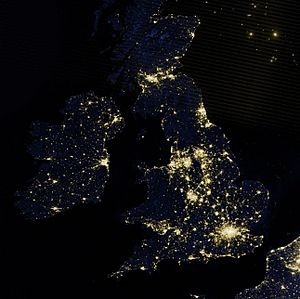
However, busy cities have grown along the coasts and rivers. They sometimes connect, forming large urban areas. For example, a long stretch of cities from the Wirral Peninsula to Doncaster includes Liverpool, Manchester, Leeds, and Sheffield. This area has over 7.6 million people. Many of these cities were small villages before the Industrial Revolution. On the east coast, ports like Kingston upon Hull and Newcastle upon Tyne grew thanks to trade. Today, Northern England is very urbanised. About 90% of its people live in city regions.
Natural Resources of the North
The Pennines have thick layers of peat. There are also many large coalfields, like those in Northumberland and Yorkshire. Gritstone, a special coarse rock used for millstones, is common in the Pennines. The different types of rock influence the buildings. For example, Chester has bright red sandstone buildings.
The richest iron ore is found in Cumbria and the North East. Salt mining has a long history in Cheshire. The UK's two remaining rock salt mines are in the North. Most of Northern England has very soft water, which affected both industry and even the taste of tea!
Northern England's Climate
Northern England has a cool, wet oceanic climate. Overall, it is cooler, wetter, and cloudier than England as a whole. It has England's coldest spot (Cross Fell) and rainiest spot (Seathwaite Fell). However, it gets less rain than Scotland or Wales. The weather varies a lot due to mountains and the sea.
Winds from the Atlantic Ocean bring moisture. This means the west coast gets strong winds and heavy rain. The east coast is in a rain shadow behind the Pennines. So, Teesside and the Northumbrian coast are the driest parts of the North. Parts of the Lake District get over 3200 mm of rain each year. Warmer areas are in the southern lowlands, like Cheshire. The east coast sometimes gets a special sea fog called fret.
| Climate data for the England N climate region, 1981–2010 | |||||||||||||
|---|---|---|---|---|---|---|---|---|---|---|---|---|---|
| Month | Jan | Feb | Mar | Apr | May | Jun | Jul | Aug | Sep | Oct | Nov | Dec | Year |
| Mean daily maximum °C (°F) | 6.4 (43.5) |
6.6 (43.9) |
8.8 (47.8) |
11.4 (52.5) |
14.7 (58.5) |
17.3 (63.1) |
19.4 (66.9) |
19.1 (66.4) |
16.5 (61.7) |
12.8 (55.0) |
9.1 (48.4) |
6.7 (44.1) |
12.4 (54.3) |
| Mean daily minimum °C (°F) | 0.7 (33.3) |
0.6 (33.1) |
2.1 (35.8) |
3.4 (38.1) |
6.0 (42.8) |
8.9 (48.0) |
11.0 (51.8) |
10.9 (51.6) |
8.9 (48.0) |
6.2 (43.2) |
3.2 (37.8) |
0.9 (33.6) |
5.3 (41.5) |
| Average precipitation mm (inches) | 94.1 (3.70) |
69.2 (2.72) |
75.2 (2.96) |
64.9 (2.56) |
61.0 (2.40) |
71.9 (2.83) |
72.3 (2.85) |
82.4 (3.24) |
80.8 (3.18) |
100.6 (3.96) |
98.1 (3.86) |
99.2 (3.91) |
969.8 (38.18) |
| Average precipitation days (≥ 1 mm) | 14.2 | 11.1 | 12.5 | 10.9 | 10.5 | 10.7 | 10.7 | 11.5 | 10.9 | 13.6 | 14.3 | 13.7 | 144.5 |
| Mean monthly sunshine hours | 49.4 | 70.5 | 101.9 | 142.4 | 182.8 | 166.7 | 175.6 | 164.0 | 126.7 | 94.0 | 58.7 | 43.5 | 1,376.2 |
| Source: Met Office | |||||||||||||
Language and Unique Accents
English Dialects in the North
The English spoken in the North today has been shaped by history. Some dialects still have features from Old Norse and old Celtic languages. Famous Northern dialects include Geordie (Newcastle), Mancunian (Manchester), and the Yorkshire dialect.
One way to tell Northern accents from Southern ones is how they say words like "bath" and "castle." Northerners often use a short 'a' sound. Also, most Northern accents are non-rhotic, meaning they don't pronounce the 'r' sound at the end of words like "car." Many Northern accents also don't distinguish between words like "put" and "putt."
Some old words like "thou" and "thee" (meaning "you") still exist in very rural Northern dialects. Many dialects also use "me" instead of "my" (e.g., "me car").
As cities grew, new urban accents appeared. These can be very different from older rural accents. However, Northern English dialects are a big part of the region's culture. People want to keep their local identity, so accents like Scouse (Liverpool) and Geordie are becoming even more unique.
Other Languages Spoken
There are no official minority languages in Northern England. However, some old Celtic counting systems like "Yan Tan Tethera" are still found in rural areas.
New accents and dialects have also formed from contact with immigrant languages. For example, the English spoken by Poles in Manchester is unique. Some languages that are rare in the UK are common in certain Northern towns. For instance, Pashto is spoken by more people in Bradford than nationally.
A Look at Northern England's History
Ancient Times and the Ice Age

During the Pleistocene ice ages, Northern England was covered in ice. This means there's not much proof of early human life. However, the oldest cave art in Europe is at Creswell Crags in Derbyshire. It shows signs of Neanderthals living there 50,000 to 60,000 years ago.
People started settling more in the Mesolithic era. Star Carr in North Yorkshire is a very important site from this time. It has Britain's oldest known house, from around 9000 BC.
In the Bronze Age, people farmed the Lincolnshire Wolds and Yorkshire Wolds. The famous Ferriby Boats were found near Hull. In the mountains, people lived in hillforts and raised animals.
Romans and Iron Age Tribes
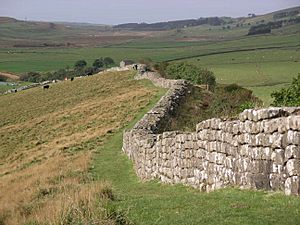
The Roman Empire called the main tribe in Northern England the Brigantes. They were known as "Highlanders." The Romans conquered them in the 70s AD. The North became the Roman province of "Britannia Inferior." Its capital was Eboracum (modern York).
Eboracum and Deva Victrix (modern Chester) were the main Roman army bases. The northernmost border of the Roman Empire was Hadrian's Wall. The Romans tried to conquer land beyond the River Tyne but never fully succeeded.
Anglo-Saxons and Vikings Arrive
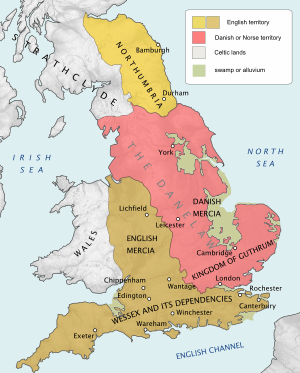
After the Angles, Saxons, and Jutes arrived, the "Old North" was split into kingdoms. Bernicia and Deira later joined to form Northumbria. This kingdom had a "Golden Age" of culture and learning. Parts of the North West kept a Celtic culture and language called Cumbric.
During the Viking era, parts of the North were controlled by the Danes (the Danelaw). Viking rule changed many things, including some funeral customs. Many place names and surnames in Yorkshire still show Viking influence.
Norman Conquest and Medieval Times

In 1066, William the Conqueror took over England. The people in the North resisted. To stop the rebellion, William ordered the Harrying of the North. In 1069–1070, many towns and farms in Yorkshire and other areas were destroyed. This caused a terrible famine. The region was left deserted.
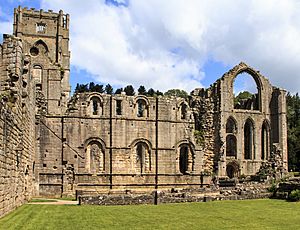
After the Normans took control, monasteries returned. They helped rebuild the North. Cistercian monasteries like Fountains Abbey in North Yorkshire became very rich. Many people from Flanders also moved to the North.
The North also saw fighting during the Wars of the Roses. This war is often seen as a fight between Lancashire and Yorkshire. However, both sides had supporters from across the North. The Anglo-Scottish Wars also affected the region. Berwick-upon-Tweed, England's northernmost town, changed hands many times.
Early Modern Era and Conflicts
After the English Reformation, Catholics in the North rebelled against the king. The Pilgrimage of Grace in Yorkshire was the largest uprising. Later, Elizabeth I faced another Catholic rebellion, the Rising of the North. Many Catholic families in Cumbria, Lancashire, and Yorkshire refused to become Protestant.
The North was also a key battleground during the Wars of the Three Kingdoms. King Charles I moved his court to York. Northern England became a base for the Royalist forces. However, they were defeated at the Battle of Marston Moor.
The Industrial Revolution Transforms the North

At the start of the Industrial Revolution, Northern England had lots of coal and water power. Farming was poor in the mountains, so workers were cheap. Mining and milling grew rapidly. The boom in textile making was huge. Some say the damp climate and soft water helped.
Easy access to coal and iron led to steelmaking. High-quality steel then helped build shipyards along the coasts. Places like Tyneside and Barrow-in-Furness became famous for building ships.
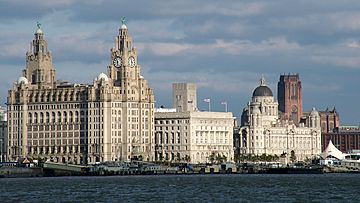
The Irish Potato Famine in the 1840s brought many Irish people to Northern cities. They settled in places like Manchester and Liverpool. This led to some anti-Catholic riots. People from other European countries also moved to the North. Some were rich business owners, others were fleeing poverty. At the same time, many Northerners moved overseas, especially to the US and Canada.
Deindustrialisation and Modern Times
The First World War changed the North's economy. In the years between the wars, the North's economy fell behind the South's. During the Great Depression, unemployment was much higher in the North. Demand for ships, steel, coal, and textiles all dropped. Northern factories were often using old technology.
During the Second World War, Northern industrial cities were major targets for bombing. The Blitz caused huge damage in cities like Liverpool and Manchester. After the war, cities were rebuilt. Many old neighborhoods were torn down and replaced. People from the "New Commonwealth" (like Pakistan and Bangladesh) moved to the North in the 1950s and 60s.
The decline of industry continued in the 1970s and 80s. This led to more job losses. The miners' strike in 1984–85 caused great hardship. This period strengthened the unique Northern English identity.
The region also saw some IRA attacks. The 1996 Manchester bombing was the largest bomb in Great Britain since World War II. It destroyed much of central Manchester. However, this attack also allowed the city to rebuild and become a leading example of modern urban development.
People and Culture in Northern England
Population and Diversity
In 2011, Northern England had almost 15 million people. This was a 5.1% increase since 2001. Northerners make up 28% of England's population. About 8% of people in Northern England were born overseas. This is less than the average for England and Wales (13%).
Most people (90.5%) described themselves as white. Other groups include Pakistani (2.9%), Indian (1.3%), and Black (1.3%). Some areas are very diverse, like Manchester and Bradford. Other areas, like Allerdale, are mostly White British.
Languages Spoken

About 95% of people in the North speak English as their first language. Another 4% speak it well or very well. The other 5% mainly speak European or South Asian languages. The most common languages after English are Polish, Urdu, and Punjabi.
Religious Beliefs
In 2011, the North East and North West had the most Christians in England and Wales. Yorkshire and the North West also had many Muslims. Other faiths made up less than 2% of the population.
The Church of England in the North is led by the Archbishop of York. This shows that Northern England has been seen as a special cultural region for a long time. The Roman Catholic Church in the North is led by the Archbishop of Liverpool.
Culture and Identity of the North
For centuries, different parts of the North had their own cultures. But with industrial growth and the North–South divide, a common Northern identity grew. At first, this identity was a reaction to Southern stereotypes. The North was often seen as dirty and uncultured.
However, Northerners began to see their own strengths. They are often seen as straight-talking, tough (with "grit"), and warmhearted. Northern England, especially Lancashire, has a tradition of strong women who manage the home and family money. This started when mills offered good jobs for women. Northern women are still often seen as strong and independent.
Traditional Clothing
Northern England is often linked to the clothes worn by working-class people in the past. Men wore heavy jackets, trousers with braces, and a flat cap. Women wore dresses or skirts with an apron. They often wore a shawl in colder weather. Some people wore English clogs, which were very durable. A folk dance called clogging developed from factory workers tapping their feet.
These traditional clothes became less popular in the late 20th century. But some items, like the flat cap, are making a comeback today.
Northern Cuisine: Food and Drink
Northern English food is often thought of as the working-class diet of the early 1900s. This included foods like black pudding and mushy peas. Some Northern dishes, like Yorkshire pudding and Lancashire hotpot, are now popular across the UK.
The North is known for its crumbly cheeses, like Cheshire cheese and Yorkshire Wensleydale. These cheeses are often moist and sharp-tasting. Sweet treats are also popular, such as Parkin, an oatmeal cake with ginger.
When it comes to drinks, the North is known for brown ales like Newcastle Brown Ale. These beers are usually served with a thick foam head. The North, especially Lancashire, was also important for temperance bars. These places sold soft drinks like dandelion and burdock and Vimto.
Recent immigration has also changed Northern food. The Teesside parmo is a local dish inspired by Italian-American food. There are large Chinatowns in Liverpool, Manchester, and Newcastle. Cities like Bradford are famous for their curry restaurants.
Literature from the North
The wild landscapes of Northern England have inspired many writers. The poems of William Wordsworth and the novels of the Brontë sisters are famous examples. Children's books like The Secret Garden also show these landscapes as places of adventure. Poets like Ted Hughes have used Northern English dialects in their work.
The industrial cities also led to many realistic stories. Writers like Elizabeth Gaskell showed working-class life. After World War II, many "angry young men" writers from the North wrote about life during industrial decline.
Music of Northern England
Traditional folk music in Northern England mixes English and Scottish styles. In the Middle Ages, many Northern folk songs used bagpipes. The British brass band tradition also started in Northern England. These bands provided entertainment and led protest marches. Brass bands are still a symbol of the North today.
Northern England also has a lively popular music scene. Famous music movements include Merseybeat from Liverpool (which gave us The Beatles), Northern soul, and Madchester. Sheffield is known for electronic pop bands like Pulp. The rivalry between bands like The Beatles and The Rolling Stones, or Oasis and Blur, often highlighted the cultural differences between North and South.
Media and Communication
Television in the North
Both the BBC and ITV have offices and studios in the North. Much of their TV production has moved to MediaCityUK in Salford. Channel 4 also moved its headquarters to Leeds. Three of the four main evening soap operas are set and filmed in Northern England: Coronation Street, Emmerdale, and Hollyoaks. The region is also known for its drama series, like Shameless.
Newspapers in the North
No major national newspaper is based in the North anymore. Northern news stories are often not well covered in national papers. The Yorkshire Post focuses mainly on news from Yorkshire and the North East. Local newspapers are very popular in the North East and Yorkshire. However, many regional newspapers have seen fewer readers recently.
Internet and Mobile Coverage
Manchester Network Access Point is the only internet exchange point outside London. Internet access in Northern homes is similar to the UK average. But speeds can vary a lot. Rural areas often have very slow or no high-speed internet. Mobile phone coverage is also better in cities than in rural parts of the North.
Sports and Rivalries
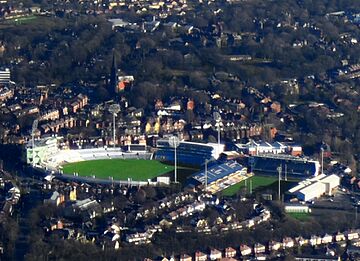
Sport has brought people together in Northern England. But local rivalries, like the Lancashire–Yorkshire Roses rivalry, have also created divisions. As cities grew, sports teams gave people a sense of belonging.
Many early Northern sports players were working class. They needed to be paid for missing work to play. Southern teams, however, believed in amateurism (not paying players). This difference led to a split in rugby. The North is also linked to animal sports like dog racing with whippets, though these are less popular now.
Manchester hosted the 2002 Commonwealth Games. This left the city with great sports facilities. The 2014 Tour de France started in Leeds. The Great North Run in Tyneside is the UK's biggest running event.
Football in the North
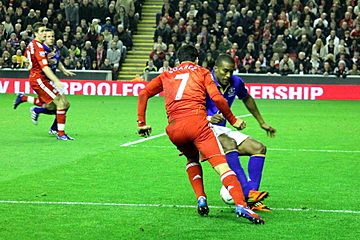
The first football club in the UK, Sheffield F.C., was founded in 1857. Early Northern teams often played by different rules. In 1883, Blackburn Olympic, a team of factory workers, won the FA Cup. This was a big moment.
When teams started paying players, the English Football League was formed in 1888. It was based in Preston, showing its Northern roots. Women's football also started in Northern factories during World War I. However, the FA banned it in 1921.
Many of England's most powerful football clubs are from the North. Since 1888, Northern teams have won most of the top league titles. Everton, Liverpool, Manchester United, and Manchester City are famous examples. Many top English players were born in the North.
Rugby in the North
In 1895, teams from Lancashire and Yorkshire split from the Rugby Football Union. They formed the Rugby Football League because they wanted to pay players. This led to the two different forms of rugby: rugby union and rugby league. Rugby league is still very strong in Northern England, especially along the "M62 corridor" between Liverpool and Hull. Most teams in the top Super League are from the North.
Rugby union also has a history in the North. In 1979, a Northern team was the only one to beat the All Blacks. Today, Northern rugby union clubs like Sale Sharks and Newcastle Falcons play in the top English league.
Cricket in the North
Cricket is very popular in Northern England. Three counties have top-level teams: Durham, Lancashire, and Yorkshire. The Roses Match between Lancashire and Yorkshire is a fierce rivalry. This rivalry helped create a shared Northern identity.
Northern teams were known for their slow, defensive style of play. This sometimes led to arguments with the London-based cricket authorities. Durham is a newer team to top-flight cricket, joining in 1992. They have won the County Championship three times.
Education in Northern England
Before the 1800s, there were no universities in Northern England. The first was the University of Durham, founded in 1832. Later, many "redbrick universities" were built, like those in Leeds, Liverpool, and Manchester. Today, seven Northern universities are part of the Russell Group, which includes leading research universities.
There is a difference in school results between Northern and Southern schools. Northern students are less likely to get top GCSE grades. Fewer Northern students go to Oxbridge universities (Oxford and Cambridge). There are calls for more investment in education in the North to help close this gap.
Images for kids
-
The Baltic Centre for Contemporary Art, formerly an industrial building, is a symbol of the regeneration of Gateshead.
See also
 In Spanish: Norte de Inglaterra para niños
In Spanish: Norte de Inglaterra para niños


